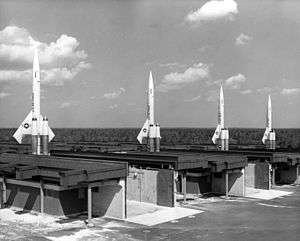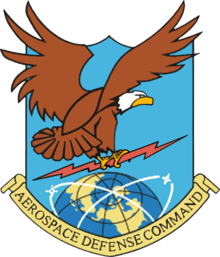46th Tactical Missile Squadron
The 46th Tactical Missile Squadron is an inactive United States Air Force unit. It was last assigned to the 35th Air Division of Air Defense Command (ADC) at McGuire Air Force Base, New Jersey. It was last active in 1972.
46th Tactical Missile Squadron
   | |
|---|---|
 46th Air Defense Missile Squadron CIM-10 Bomarc missile battery | |
| Active | 1942-1949; 1959-1972 |
| Country | |
| Branch | |
| Type | Troop Carrier, Surface to Air Missile |
| Role | Airlift, Air defense |
| Size | squadron |
| Motto(s) | The First and the Finest (1959-1972) |
| Insignia | |
| 46th Air Defense Missile Squadron emblem (approved 5 May 1960)[1] | |
| 46th Troop Carrier Squadron emblem (approved 13 January 1943)[2] |  |
History
Airlift Operations

The squadron was first activated under the 317th Transport Group (later 317th Troop Carrier Group), an element of Air Transport Command (later I Troop Carrier Command) in May 1942[2] as the group expanded from three to four squadrons.[3] The group and squadron equipped with Douglas C-47 Skytrains and trained at several airfields in Texas, the midwest and the southeast.[2] It also performed various airlift missions as part of its training. The squadron deployed to Australia, arriving in January 1943[2] as an element of Fifth Air Force.[3] It made numerous flights in unarmed planes over the Owen Stanley Range transporting reinforcement and supplies to Wau, Papua New Guinea, where enemy forces were threatening a valuable Allied airdrome, for which it was awarded a Distinguished Unit Citation.[3] It performed paratroop drops at Nadzab (the first airborne operation in the Southwest Pacific)[3] and Noemfoor in New Guinea; Tagaytay, Luzon, and Corregidor and Aparri in the Philippines.[2] Also performed cargo airlift, supply and evacuation, and other assigned missions along the northern coast of New Guinea; the Dutch East Indies and in the Philippines as part of MacArthur's island hopping offensive against the Japanese in the Southwest Pacific. This included supplying guerillas in Mindanao, Cebu, and Panay.[3] In April 1945, it bombed Carabao Island with drums of napalm.[3]
The squadron deployed to Okinawa in August 1945 after the Japanese capitulation[2] and became part of the American occupation forces. It replaced its C-47s with longer range Curtiss C-46 Commando aircraft and moved to Japan and the Korean peninsula during late 1945.[2] Its initial post-war missions included the evacuation of former Allied prisoners of war; later primarily cargo transport missions in the occupied areas of Japan and Korea during the postwar era. The squadron inactivated in 1949 in Japan[2] due to budget constraints; its aircraft being assigned to other units as part of the consolidation.
Cold War Air Defense
The squadron was activated as the 46th Air Defense Missile Squadron (BOMARC) in 1959 at McGuire Air Force Base, New Jersey,[4] and stood alert during the Cold War, with IM-99A (later CIM-10) BOMARC surface to air antiaircraft missiles. The squadron was tied into a Semi-Automatic Ground Environment (SAGE) direction center which could use analog computers to process information from ground radars, picket ships and airborne aircraft[5] to accelerate the display of tracking data at the direction center to quickly direct the missile site to engage hostile aircraft.[6] It trained personnel and prepared for operation of the BOMARC surface-to-air missiles; operated and maintained BOMARC missiles and associated equipment, trained personnel, and maintained a capability to intercept and destroy hostile aircraft until inactivation.[1] The squadron was inactivated on 31 October 1972, one of the last two BOMARC missile squadrons inactivated.[4]
The BOMARC missile site was located 4 miles (6.4 km) east-southeast of McGuire Air Force Base at 40°02′06″N 074°26′29″W. Although geographically separated from the base, it was an off base facility of McGuire and the squadron received administrative and logistical support from McGuire.[7]
Consolidation
The 46th Troop Carrier Squadron and the 46th Air Defense Missile Squadron were consolidated on 19 September 1985 as the 46th Tactical Missile Squadron while remaining inactive.[1]
Lineage
46th Troop Carrier Squadron
- Constituted as the 46th Transport Squadron on 30 May 1942[2]
- Activated on 15 June 1942[2]
- Redesignated as the 46th Troop Carrier Squadron on 4 July 1942[2]
- Redesignated as the 46th Troop Carrier Squadron, Medium on 10 August 1948[2]
- Inactivated on 1 April 1949[2]
- Consolidated with the 46 Air Defense Missile Squadron on 19 September 1985[1]
46th Air Defense Missile Squadron
- Constituted as the 46th Air Defense Missile Squadron (BOMARC) on 10 Dec 1958
- Activated on 1 Jan 1959[4]
- Inactivated on 31 Oct 1972[4]
- Consolidated with the 46 Troop Carrier Squadron on 19 September 1985[1]
Assignments
- 317th Transport Group (later 317th Troop Carrier Group), 15 June 1942[2]
- Fifth Air Force, 18 August 1948 - 1 April 1949 (attached to 317th Troop Carrier Wing), 18 August 1948, 6146th Station Group, 1 October 1948, 374th Troop Carrier Group, 5 March 1949 - 1 April 1949[2]
- New York Air Defense Sector, 1 Jan 1959[4]
- 21st Air Division, 1 Apr 1966[4]
- 35th Air Division, 1 Dec 1967 - 1 Oct 1972[4]
Stations
|
|
Awards and campaigns
| Award streamer | Award | Dates | Notes |
|---|---|---|---|
| Distinguished Unit Citation | 30 January 1943-1 February 1943 | 46th Troop Carrier Squadron, Papua New Guinea[2] | |
| Distinguished Unit Citation | 16 February 1945-17 February 1945 | 46th Troop Carrier Squadron, Philippine Islands[2] | |
| Philippine Republic Presidential Unit Citation | 19 November 1944-4 July 1945 | 46th Troop Carrier Squadron[2] |
| Campaign Streamer | Campaign | Dates | Notes |
|---|---|---|---|
| Papua | 23 January 1943 | 46th Troop Carrier Squadron[2] | |
| New Guinea | 24 January 1943 – 31 December 1944 | 46th Troop Carrier Squadron[2] | |
| Northern Solomons | 23 February 1943 – 21 November 1944 | 46th Troop Carrier Squadron[2] | |
| Bismarck Archipelago | 15 December 1943 – 27 November 1944 | 46th Troop Carrier Squadron[2] | |
| Leyte | 17 October 1944 – 1 July 1945 | 46th Troop Carrier Squadron[2] | |
| Luzon | 15 December 1944 – 4 July 1945 | 46th Troop Carrier Squadron[2] | |
| Southern Philippines | 27 February 1945 – 4 July 1945 | 46th Troop Carrier Squadron[2] | |
| World War II Army of Occupation (Japan) | 3 September 1945 – 1 April 1949 | 46th Troop Carrier Squadron[2] |
Aircraft and missiles
- Douglas C-47 Skytrain, 1942–1945
- Curtiss C-46 Commando, 1945–1949
- Boeing IM-99 (later CIM-10) BOMARC, 1959-1972
See also
References
Notes
- Kane, Robert B. (September 24, 2009). "Lineage & Honors Statement 46th Tactical Missile Squadron" (PDF). Air Force Historical Research Agency. Archived from the original (PDF) on July 17, 2011. Retrieved August 21, 2010.
- Maurer, Combat Squadrons, p. 205
- Maurer, Combat Units, pp. 195–196
- Cornett & Johnson, p. 150
- Winkler & Webster, p. 39
- Winkler & Webster, p. 3
- Mueller, p. 412
Bibliography
![]()
- Cornett, Lloyd H; Johnson, Mildred W (1980). A Handbook of Aerospace Defense Organization, 1946–1980 (PDF). Peterson AFB, CO: Office of History, Aerospace Defense Center.
- Maurer, Maurer, ed. (1983) [1961]. Air Force Combat Units of World War II (PDF) (reprint ed.). Washington, DC: Office of Air Force History. ISBN 0-912799-02-1. LCCN 61060979.
- Maurer, Maurer, ed. (1982) [1969]. Combat Squadrons of the Air Force, World War II (PDF) (reprint ed.). Washington, DC: Office of Air Force History. ISBN 0-405-12194-6. LCCN 70605402. OCLC 72556.
- Mueller, Robert (1989). Air Force Bases, Vol. I, Active Air Force Bases Within the United States of America on 17 September 1982 (PDF). Washington, DC: Office of Air Force History. p. 412. ISBN 0-912799-53-6.
- Winkler, David F.; Webster, Julie L (1997). Searching the skies: The legacy of the United States Cold War Defense Radar Program. Champaign, IL: US Army Construction Engineering Research Laboratories. p. 39. LCCN 97020912.
.svg.png)



